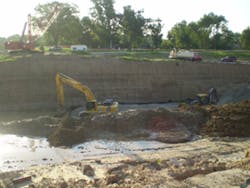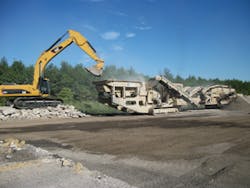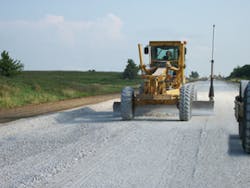This project has to rank as one of the most challenging 2.2 miles of highway to build anywhere in the nation. It’s a new alignment for Highway 141 in St. Louis, MO, and it passes through a floodplain with two substantive creeks, plus tributaries, running through the area. There are eight bridges to build totaling 2,437 feet in length-and 113,000 square feet of mechanically stabilized earth walls to erect.
So it’s a swampy area, and this spring and early summer were among the wettest periods on record in the St. Louis area. “We’re contending with the worst precipitation totals in recorded history right now,” says Jesse Jonas, P.E., resident engineer for the owner, the Missouri DOT (MoDOT).
What’s more, the heavily populated area is filled with utilities. It cost $20 million to relocate the existing utilities so the new six-lane highway can go through, says Jonas.
Enter Fred Weber Inc., the St. Louis contractor that won the $55 million contract to build the job. Of that, $10 million is going to subcontractor
Kolberg Pioneer crushing plant processes recycled concrete.
Bates Construction for installing a 60-inch trunk sewer, sanitary-type, through the alignment. The sewer was placed in Fred Weber’s contract to give Weber control over the schedule.
Meanwhile, Weber has approximately 900,000 cubic yards of earth to move. “We cannot waste any fill onsite,” says Justin Brooks, Weber’s project manager. “Any dirt we move has to go into the designed fill or be disposed offsite. FEMA, the Federal Emergency Management Agency, gets involved. They have to make sure that the project will not cause water to rise and flood the area.”
Using a Komatsu PC 400 excavator and a Hitachi excavator, Weber is digging the cut-which ranges up to 30 feet deep-and hauling earth to the fill with four Sterling trucks. “The challenge of the project is the wet dirt and it just keeps raining here,” says Brooks.
Catching Up
The major fill will be an embankment with portions 12 feet high. The fill will measure 100 feet wide at the top. “We’re running a Cat D6 dozer to spread out the dirt and compacting it with a Cat 815 sheepsfoot roller,” says Brooks. Because of all the rain, the project was somewhat behind schedule in early July. Production was running at about 3,000 cubic yards per day, less than Weber would like.
“We’re working with MoDOT on some ways to catch up on the schedule,” says Brooks. Such ways might include double-shifting the earthmoving operation or going to lime stabilization at the fill. Lime stabilization would allow the contractor to spread the fill in thicker layers and drive up production. Construction began in April 2010 and is slated for completion in September 2012.
Two of the bridges are complete, and Weber planned to start construction on two more in July. The bridges range from single spans up to multiple spans, and consist of exposed steel bents with concrete girders. Bridge construction involved a Manitowoc 222 crawler crane and a Manitowoc 777 crawler crane, both to drive piles and set girders. Meanwhile a Grove crane picked up lighter duties such as lifting rebar and swinging concrete.
Green Credits
To “go green” with this project, MoDOT is offering green credits to Fred Weber Inc., with monetary incentives attached for earning more green credits. If Weber meets the basic goal of 20 green credits, the contractor will earn a $5,000 bonus. For 25 green credits, the incentive is $10,000 and it ranges up to $15,000 for 30 credits.
To help earn credits, Weber is using biodiesel fuel in all diesel engines. And the contractor hired a logger to clear the site for the fill. All the trees that could go for dimension lumber, or furniture, were recycled in that way-and the purposes were all documented. Wood that could not be logged was ground up onsite. “We built mulch berms, and they work better than silt fences,” says Brooks.
Any concrete that was torn from the old highway was recycled as fill. Reclaimed asphalt pavement was recycled into new asphalt mixtures. It is expected that a nearby site can use 20,000 cubic yards of earth fill to build a soccer field. So that means the earth will not be hauled far away and that’s good for green credits. “We’re confident that we’ll at least meet the goal of earning 20 green credits,” says Brooks.
Robotic total stations provide precise X and Y
location information to the paver, while the digital model supplies elevation information.
International Attention
The project has gained international attention because short sections will help demonstrate the expected environmental benefits of using concrete paving materials blended with a photo-chemically active agent, titanium dioxide. Two such innovative paving materials will be studied, including a photocatalytic concrete mainline pavement and a photocatalytic pervious concrete shoulder pavement.
“We call it smog-eating concrete,” says Jonas. “The cement enables the concrete to capture harmful pollutants from auto exhaust fumes. It captures SOx and NOx gases, and with help from the sun’s ultra-violet rays, the pavement will break down the harmful pollutants and turn them into harmless byproducts.”
The trade name of the product is TX Active. It was developed by Essroc Italcementi Group, an Italy-based cement manufacturer, and has been used extensively on buildings for self-cleaning and de-polluting purposes.
The first mainline pavement material will be applied using a two-lift approach. The lower, base level concrete will be constructed with less expensive materials-a lower cement content. The top-wearing course is applied immediately with the photocatalytically active concrete called TX Active.
The second shoulder element of the research will involve a similar photolytic concrete material that also contains the titanium dioxide admixture. But in the second instance the titanium dioxide will be blended into a pervious concrete. “Together, this set of innovative…materials are believed to represent one of the most technically advanced and environmentally friendly concrete paving systems ever employed in our country,” says a draft proposal for the research.
Monitoring systems will be set up to assess the environmental impact of the new concrete. Project air quality impact assessment is being carried out by Iowa State University, as is project management and oversight. Project water quality impact-from the pervious concrete-will be handled by the University of Missouri in Kansas City. The Federal Highway Administration and MoDOT are taking care of project implementation.
Going Stringless on the Interstate
“Our stringless concrete paving system is fantastic,” says Mark Gorton, project manager for Flynn Co. Inc., a Dubuque, IA, concrete paving contractor. Flynn has invested nearly $300,000 in Leica Geosystems machine controls for a mainline concrete paver, two grade trimmers, a motor grader and a dozer.
Because of their accuracy, machine controls produce somewhat smoother pavements than a stringline. And because many states offer contractors incentives for smoother pavements, that accuracy can lead to increased incentive payments based on smoothness measurements.
For example, Flynn achieved some excellent smoothness results last year on an 11-inch thick concrete pavement on Interstate 35 in Clarke County, IA. Working 32 feet wide, a four-track Guntert & Zimmerman S850 mainline paver-automatically controlled by a PaveSmart 3D system from Leica Geosystems-squeezed profilograph numbers down to just 13 to 18 inches of deviation per mile from a zero blanking band. Those numbers, says Gorton, were good enough to earn Flynn more than 90 percent of the total allowable smoothness incentives paid by the Iowa DOT. The project was approximately 10.5 miles long.
It’s difficult to quantify, but co-owner Jeff Flynn is satisfied that machine control equipment pays for itself by eliminating not only the labor and cost of stringline, but the little variables that are intrinsic to the stringline process. Those little variables add up to a “monster benefit,” he says. For example, if a stringline pin is set near a soft spot in the haul road, the concrete trucks can pump the haul road at that location and throw the stringline off grade.
Or if the stringline is set up next to the area where you place base stone material, a worker must hold down the stringline while stone trucks cross over it. Or if you’re using a belt placer and the dump man lowers the belt hopper onto a stringline pin, it will tear the belt up and you’ll lose a day of paving to replace the belt. Plus, workers can trip on a stringline and injure themselves.
The PaveSmart 3D machine control system from Leica Geosystems bases its guidance on a digital model of the pavement that is entered into a Leica computer onboard the paver. The paver has two prisms, mounted above the machine, to receive signals from two robotic total stations set up on tripods in front of the paver. The prisms on the paver have a relation to four points on the slipform concrete paver’s pan, which extrudes concrete for the runway.
When setting up the total stations, a technician back-sights each of them to three known control points. That fixes the location of the total stations relative to the digital model. The total stations can then “see” two prisms on the paver and communicate to the paver-by free-wave radio-the paver’s precise location. The onboard computer then processes the differences between the actual paver location and the digital model. Knowing those differences, the computer controls the paver pan location automatically.
Flynn actually uses three robotic total stations to control the paver, but only two are active at one time. When the paver moves ahead about 500 feet, out of range of one total station, a technician moves the third total station ahead and activates it to one of the prisms. That way the paver does not stop while a total station is being relocated. “The robots tell the paver it’s at X and Y location, and the digital model tells the paver it needs to be at elevation Z,” says Gorton.
When the base has been prepared, the contractor sets out dowel baskets-contraction dowel assemblies with 1-inch diameter bars-in lines spaced across the grade at 20-foot intervals down the roadway. The dowels accomplish load transfer across the 20-foot joints to be sawed in the concrete pavement. A Rex Town and Country belt placer, steered by a stringline, supplies concrete and strikes it off ahead of the paver.
“The G&Z paver gives us a fantastic ride with a stringline, and we have found that it’s even smoother with the Leica machine-control system,” says Gorton. The Iowa DOT’s smoothness specification is 26 inches of deviation per mile, from a zero blanking band, to receive full payment. A graduated incentive system results in more money for less deviation. “The stringless system won’t take a 20-inch (stringline) ride to an 8-inch, but it will take a 20-inch to an 16-inch,” says Gorton.
For the Interstate 35 project, Flynn relied on subcontractor C.J. Moyna & Sons, Elkader, IA, to remove and recycle the existing pavement onsite. The aging and deteriorated pavement consisted of a 6-inch asphalt base topped by 9 inches of concrete that had been overlaid with 4 to 6 inches of asphalt.
After the top layer of asphalt had been milled off, a guillotine breaker broke up the concrete and a Caterpillar excavator removed it. Next a milling machine removed the base asphalt, and Caterpillar excavators dug out 1 foot of unsuitable material.
Then Moyna used a Kolberg Pioneer 4250 mobile crusher to process the recycled asphalt. The big crusher moved down the roadway and left a windrow of special backfill. A Caterpillar dozer spread the asphaltic backfill into a layer 1 foot thick. Compaction with a Bomag roller followed.
A second mobile crusher, this one a Kolberg Pioneer 5260, moved down the roadway while crushing the recycled concrete to 1.5-inch minus size. A Caterpillar dozer spread the crushed concrete base into a layer 6 inches thick and a Bomag compactor compressed the base material.
For the concrete paving, Gorton says the big Guntert & Zimmerman paver had a secondary crowning mechanism that could slope the shoulder differently from the mainline. The paver was placing a 14-foot driving lane, a 12-foot passing lane, and a 6-foot inside shoulder, all in one pass. So going around curves to the right, the paver could create a high point between the inside shoulder and the adjacent lane.
Flynn and Gorton were well pleased with the project. “The stringless system with Leica and the Guntert & Zimmerman paver worked wonderfully well for the Flynn Co.,” says Gorton.





